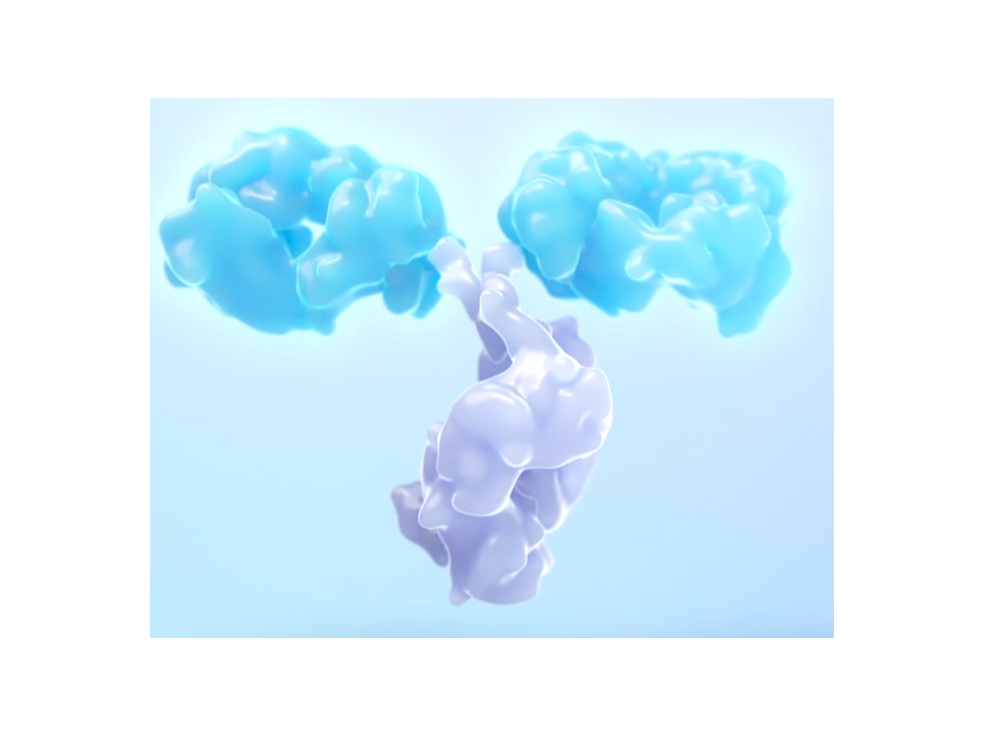Type of technology
Fusion of a therapeutic protein with a human antibody engineered to bind albumin.
Administration route
Intravenous
Development state and regulatory approval
APB-A1 (anti-CD40L agent)
Phase I
Not provided
Description
SAFA (anti-Serum Albumin Fab-Associated) is a novel technology that modifies antiserum albumin Fab fragments to create long-acting therapeutic proteins. This modified fab can be fused with antibody fragments and/or recombinant proteins. These fused constructs, termed SAFAbodies, exhibit high affinity binding to natural serum proteins. At the cellular level, these SAFAbodies bind to neonatal Fc Receptor (FcRn) to avoid degradation. This FcRn binding mechanism results in the prolonged action of the SAFA formulation i.e., prolonged half-life and targeted site of action.
Developer(s)

AprilBio is a South Korean biopharmaceutical company that is based at Gangwon University, developing specialized biologics and antibody drugs for rare diseases, oncology, autoimmune and inflammatory diseases. Their focus areas include rare diseases, oncology, autoimmune and inflammatory diseases.
Technology highlight
1) Prolonged Half-Life 2) Targeted Site of Action 3) No chemical conjugated with PEG or any other polymer 4) Flexibility in choosing protein expression system 6) Less immunogenic side effects due to no/low Fc gamma receptor (FcgR) interaction.
Illustration(s)
Technology main components
1) Genetically Modified Albumin Fusion protein 2) API 3) FcRN4 4) Excipients such as fillers, antiagglutinating agents, lubricating agents, wetting agents, flavoring agents, emulsifiers, and preservatives are added based on the API.
Not provided
Delivery device(s)
No delivery device
APIs compatibility profile
Therapeutic proteins such as Monoclonal Antibodies, Interleukins, CD-40, Granulocyte Colony-Stimulating Factor (G-CSF) analogues, Human Growth Hormone (HGH), IFN-β (Interferon Beta), checkpoint inhibitors, Follicle-Stimulating Hormone (FSH) analogues, and GLP-2 (Glucagon-Like Peptide-2) are targeted
Not provided
Not provided
75-90 wt%
1 single API :
Not provided
Scale-up and manufacturing prospects
Not provided
Not provided
The manufacturing process of the SAFA formulation involves the following key steps: • Generation of SL33X-API Fusion Constructs: This step is performed using polymerase chain reaction (PCR) amplification followed by cloning techniques to produce the desired constructs. • Preparation of Soluble Fab Fragments and SL33X-API Fusion Proteins: Soluble Fab fragments and fusion proteins are synthesized and purified as part of the formulation process. Note: The complete manufacturing process for the finalized product remains undisclosed.
• Differential scanning calorimeter (DSC) • Enzyme-linked immunosorbent assay (ELISA) • In vitro bioactivity assay • UV Spectrometer (Bio-Rad) • Sodium Dodecyl Sulfate-Polyacrylamide Gel Electrophoresis (SDS-PAGE) and Western Blot analyses (using Coomassie Blue staining)
Excipients
No proprietary excipient used
No novel excipient or existing excipient used
No residual solvent used
Additional features
- Room temperature storage
- At least 1 year shelf life
- Other(s)
Drug release from the protein fragments at intercellular level
The antigen-binding fragment (Fab) of the API specifically binds to albumin, enhancing protein binding and thereby extending the API’s half-life (~19 days), volume of distribution at steady state (Vss), and systemic clearance (CL). The prolonged release mechanism involves FcRn-mediated recycling of the Fab-albumin complex at the cellular level, resulting in the slow, sustained release of the API from the complex.
SAFA injections are administered via subcutaneous route of administration using a standard 21-gauge needle or even thinner depending on the formulation characteristics.
Preclinical animal studies show that the 4-week repeated dose toxicity revealed no abnormal toxicological symptoms.
The shelf life of the SAFA is approximately one year, with a serum stability of the SAFA-coordinated complex lasting 16 days.
Room temperature storage is possible.
Therapeutic area(s)
- Other(s) : "Male infertility, Endocrine disorders, Auto-inflammatory disease , Still's disease and Obesity"
- Oncology
- Treatment
Potential associated API(s)
- Interleukins
- Cytokines agonists
- Interleukins
- Glucagon-like peptide-1 (GLP-1) analogues (GLP-1)
- APB-R6 (TSHR analog)
- APB-R2 (FSHR analog)
- APB-A1 (anti-CD40L agent)
Use of technology
- Administered by a community health worker
- Administered by a nurse
- Administered by a specialty health worker
Weekly, Monthly
Not provided
Targeted user groups
- Adults
- Older Adults
- All
Unspecified
Unspecified
Unspecified
Not provided
Interleukins
IL-18 inhibitor
Phase I
NCT05715736
Auto-inflammatory diseases and Still's disease
Not provided
Not provided
Not provided
Cytokines agonists
Anticancerous agent
Pre-clinical
Not provided
Solid Tumors
Not provided
Not provided
Not provided
Interleukins
IL-2R inhibitor
Pre-clinical
Not provided
Autoimmune diseases
Not provided
Not provided
Not provided
Glucagon-like peptide-1 (GLP-1) analogues (GLP-1)
GLP-1R agonist (antiobesity agent)
Pre-clinical
Not provided
Obesity
Not provided
Not provided
Not provided
APB-R6 (TSHR analog)
Anterior Pituitary Hormone receptor analogues
Pre-clinical
Not provided
Endocrine Disorders
Not provided
Not provided
Not provided
APB-R2 (FSHR analog)
Anterior Pituitary Hormone Receptor analogues
Pre-clinical
Not provided
Male Infertility
Not provided
Not provided
Not provided
APB-A1 (anti-CD40L agent)
Immunosuppressants
Phase I
NCT05136053
Autoimmune diseases, such as amyotrophic lateral sclerosis, systemic lupus erythematosus, Sjögren’s syndrome or organ transplantation
Not provided
Every 2 to 4 weeks
Not provided
Anti - Serum Albumin Fab - Effector Moiety Fusion Construct And A Method Of Preparing The Construct
The present invention relates to antigen-binding fragment (Fab) and a Fab-effector fusion protein or (poly)peptide comprising thereof. The Fab of the present invention specifically binds to serum albumin and thereby has extended in vivo half-life. The Fab of the present invention is characterized by not having cysteine residues that are responsible for the interchain disulfide bond in CH1 domain and CκL domain as well. The Fab-effector fusion protein or (poly)peptide of the present invention can be produced in periplasm of E. coli with high yield, and has increased in vivo half-life. Further, the present invention provides E. coli strain which produces various kinds of Fab-effector fusion proteins or (poly)peptides, pharmaceutical composition comprising the fab-effector fusion proteins.
US9879077B2
Formulation
Aprilbio Co Ltd
Not provided
August 29, 2034
Anticipated expiration
Publications
Kang, H. J., Kim, H. J., Jung, M. S., Han, J. K., & Cha, S. H. (2017). Optimal expression of a Fab-effector fusion protein in Escherichia coli by removing the cysteine residues responsible for an interchain disulfide bond of a Fab molecule. Immunology Letters, 184, 34-42.
Development of novel bi-functional or even tri-functional Fab-effector fusion proteins would have a great potential in the biomedical sciences. However, the expression of Fab-effector fusion proteins in Escherichia coli is problematic especially when a eukaryotic effector moiety is genetically linked to a Fab due to the lack of proper chaperone proteins and an inappropriate physicochemical environment intrinsic to the microbial hosts. We previously reported that a human Fab molecule, referred to as SL335, reactive to human serum albumin has a prolonged in vivo serum half-life in rats. We, herein, tested six discrete SL335-human growth hormone (hGH) fusion constructs as a model system to define an optimal Fab-effector fusion format for E. coli expression. We found that one variant, referred to as HserG/Lser, outperformed the others in terms of a soluble expression yield and functionality in that HserG/Lser has a functional hGH bioactivity and possesses an serum albumin-binding affinity comparable to SL335. Our results clearly demonstrated that the genetic linkage of an effector domain to the C-terminus of Fd (VH + CH1) and the removal of cysteine (Cys) residues responsible for an interchain disulfide bond (IDB) ina Fab molecule optimize the periplasmic expression of a Fab-effector fusion protein in E. coli. We believe that our approach can contribute the development of diverse bi-functional Fab-effector fusion proteins by providing a simple strategy that enables the reliable expression of a functional fusion proteins in E. coli.
Ji, S. I., Park, J. H., You, H. G., Chi, H. J., Bang, Y. W., & Cha, S. H. (2019). Intact bioactivities and improved pharmacokinetic of the SL335-IFN-β-1a fusion protein that created by genetic fusion of SL335, a human anti-serum albumin fab, and human interferon-β. Immunology Letters, 207, 46-55.
Recombinant human interferon beta (rIFN-β) has long been used as a first-line treatment for multiple sclerosis (MS), and any attempt to develop a long-acting rIFN-β is desirable since only one pegylated version of long-acting rIFN-β-1a (Plegridy) is currently available in clinics. Previously, we reported that SL335, a human Fab molecule specific to serum albumin, exhibits an extended serum half-life via utilizing the FcRn recycling mechanism. With the ultimate goal of developing a long-acting rIFN-®, we generated a fusion construct by linking human IFN-β cDNA to the C-terminus of the SL335 H chain at the DNA level followed by expression of the fusion protein, referred to as SL335-IFN-β-1a, in Chinese hamster ovary-S (CHO-S) cells. In its N-linked glycosylated form, the resulting fusion protein was easily purified from the culture supernatant via a three-step chromatography process. In vitro functional assays revealed that the fusion protein retained its intrinsic binding capabilities to human serum albumin (HSA) and interferon α/β receptor (IFNAR) that were almost identical to those of parental SL335 and rIFN-β-1a (Rebif). In addition, the fusion protein possessed an antiviral potency and anti-proliferation activity comparable to those of Rebif. In pharmacokinetic (PK) analyses using Lewis rats and cynomolgus monkeys, SL335-IFN-β-1a exhibited at least a two-fold longer serum half-life and a significantly reduced renal clearance rate compared to those of Rebif. Finally, a four-week repeated dose toxicity study revealed no abnormal toxicological signs. In conclusion, our results clearly demonstrated that SL335-IFN-β-1a is worthy of further development as an alternative long-acting IFN-β therapeutic.
Additional documents
No documents were uploaded
Useful links
There are no additional links
Collaborate for development
Consider on a case by case basis, collaborating on developing long acting products with potential significant public health impact, especially for low- and middle-income countries (LMICs), utilising the referred to long-acting technology
Share technical information for match-making assessment
Provide necessary technical information to a potential partner, under confidentiality agreement, to enable preliminary assessment of whether specific medicines of public health importance in LMICs might be compatible with the referred to long-acting technology to achieve a public health benefit
Work with MPP to expand access in LMICs
In the event that a product using the referred to long-acting technology is successfully developed, the technology IP holder(s) will work with the Medicines Patent Pool towards putting in place the most appropriate strategy for timely and affordable access in low and middle-income countries, including through licensing



